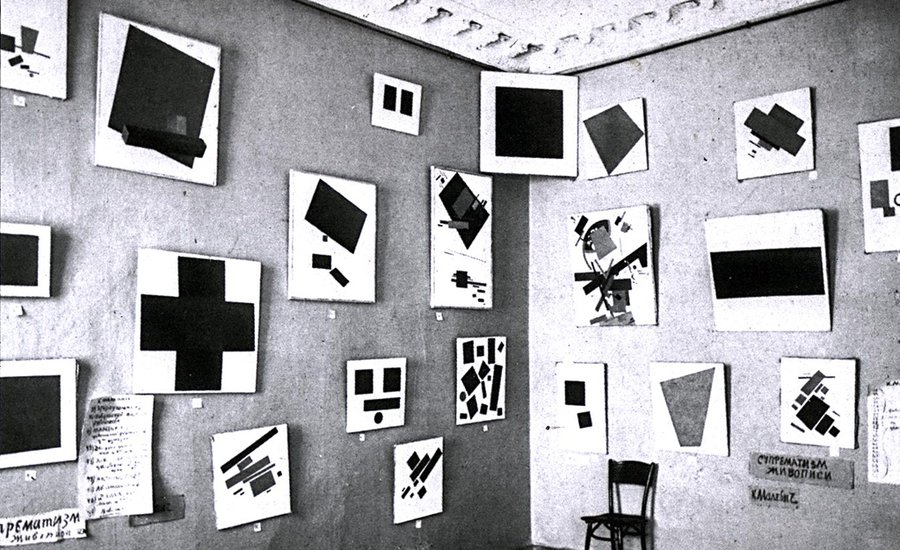What Makes Geometric Abstraction So Exciting?
By Artspace Editors
When abstract art burst onto the stage in the Western art world in the early 20th century, its practitioners quickly resolved themselves into two distinct camps: the gestural abstractionists, who built upon the liberatingly loose compositions of Post-Impressionists like Cezanne to create non-objective paintings emphasizing the artist’s hand, and the geometric abstractionists, who seized on the it-is-what-it-is essentialism of Euclidean geometric shapes.
Following the developments of Cubist and Futurist painting—in which the natural world was translated into a stark pictorial language of shapes, lines, and angles—Russia was one of the primary breeding grounds of pure abstraction, with Wassily Kandinsky doing much to popularize geometric art before gravitating to the gestural camp in later years. But it was Kazimir Malevich who today is often viewed as the forefather of geometric abstraction, beginning with his seminal 1915 paintings of black shapes—a circle, a square—on a white ground, and his legendary white-square-on-white-canvas 1919 monochrome.
 Installation view of “0.10 (Zero-Ten) The Last Futurist Exhibition of Painting.”
Installation view of “0.10 (Zero-Ten) The Last Futurist Exhibition of Painting.”
Though geometry can seem dry and mute in comparison to the flights of fancy in gestural abstraction, the artists who pursued meaning in its rigorous shapes found it anything but. Malevich—who called his visually simple but theoretically dense approach “Suprematism”—declared that his intention was to use geometry to convey “the primacy of pure feeling in creative art,” and through it he created totemic works of strange, atavistic power.
RELATED ARTICLE: What Was Suprematism? A Brief History Of The Russian Idealists Who Created Abstraction As We Know It
His confederate, El Lissitzky, on the other hand, painted lively compositions with shapes that often seem to dance on the canvas, using precise balances of shapes and colors to tell spatial stories—for instance, suggesting that a static shape is actually in the process of falling, or rising—or even convey political propaganda. (The most famous example of this is the 1919 pro-Bolshevik poster Beat the Whites With the Red Wedge.) Mondrian, of course, elevated these spatial dynamics to the point where his last painting, Broadway Boogie Woogie, nearly reverted to representationalism by so vividly evoking the traffic flow of New York City’s streets.
 Piet Mondrian, Broadway Boogie Woogie, 1942-43. Image via Wikipedia.
Piet Mondrian, Broadway Boogie Woogie, 1942-43. Image via Wikipedia.
From these beginnings, geometric abstraction endured throughout the 20th century as a visual and theoretical counterpoint to gestural movements like Abstract Expressionism, rendered by different artists in many different ways. Josef Albers, for instance, employed compositions of layered squares to explore the manifold qualities of color, considering how different hues relate to each other and their effect on the perception of viewers. Other artists brought geometric shapes into three dimensions as sculpture, with Sol LeWitt’s cubic stacks being expressions of conceptual-art ideas, Dan Flavin’s fluorescent-light arrangements functioning as paragons of Minimalism, and Richard Tuttle’s scrappy arrangements recalling the playfullness of El Lissitzky.
Sol LeWitt, Black Bands in Two Directions, 1991 is available on Artspace.com for $4,700
Meanwhile, still other artists looked back on Malevich’s monochrome with paintings that conveyed form only through the shape of the canvas, like Robert Rauschenberg’s early 1951 white paintings (which he considered stages for the interplay of ambient light and shadow) and Brice Marden’s imposing examples from the 1960s. Artists associated with “hard-edge” painting in the 1960s, such as Ellsworth Kelly, Kenneth Noland, and Frank Stella, rejected the subjective, gestural emphasis of Abstract Expressionism in favor of sharply defined areas of color.
Sarah Morris, Rings, 2009 is available on Artspace.com for $2,900
Today the lineage of geometric abstraction is being continued by younger artists in all manner of ways, from the crisp paintings of Sarah Morris that combine Mondrian’s compositional intricacy with vernacular touches to the colorful arrangements of talents like Mai Braun that pursue an obsession with color that Albers would recognize. To see a variety of approaches to this powerful approach to art, explore our geometric abstraction collection.
Geometric abstraction is a form of abstract art based on the use of geometric forms sometimes, though not always, placed in non-illusionistic space and combined into non-objective (non-representational) compositions. Although the genre was popularized by avant-garde artists in the early twentieth century, similar motifs have been used in art since ancient times. wikipedia.org




